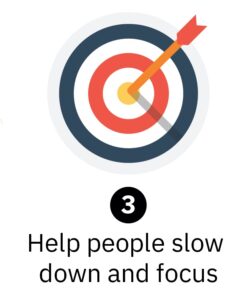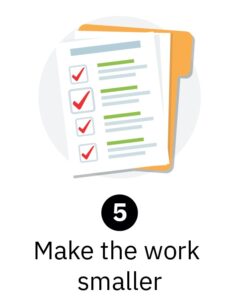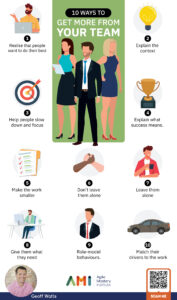How To Increase Velocity Of Your Team
Posted By - Geoff Watts

If you would prefer to watch this instead of read it, the video is at the bottom of the page.
Every leader that I have come across and worked with would love their teams to increase velocity. They all want their teams to deliver more stuff quicker. Now I am an impatient person myself too. So, even though I know it’s not necessarily a good thing, sometimes I find myself subtly hassling other people to try and go a little bit faster.
I know that the most likely consequences of pushing someone to go a little bit faster is a compromising of quality. This is because either that person is going to consciously cut some corners here and there in order to meet a new deadline or they’ll feel under pressure to work longer hours and they’ll make mistakes without realising.
So if you are a leader of a team how can you increase velocity of your team without compromising quality?
Well this is a touchy subject but I think I’ve got some tips that might be able to help you.
The first tip is to realise that people want to do their best.
People aren’t inherently lazy; they don’t deliberately want to underperform. Sure there are times when they want to do the bare minimum…we all do…but, given the choice, people would rather do better than not and that’s a worthwhile thing to remember.
I was working with a group of people a few years ago now and one of the people in the room decided to share his view that people are inherently lazy. He believed that in order to make sure that anything of worth got done people needed to be managed. He was forthright in his view and he genuinely believed that.
You could tell that he also had multiple examples of evidence of his philosophy and his view of people being true to him. There was no way that my philosophical view was going to have any impact on him because he had seen his truth.
I was prepared to just agree to disagree. However one of his colleagues decided to offer an alternative perspective. Remember this is someone from the same organisation. This person said
“It’s strange you should say that because my people are pretty good and we’re operating in the same environment so are you just hiring badly? Is that the reason why your people aren’t trustworthy, aren’t proactive and need to be managed or is there something else going on?”
And we had a debate for a while. It was an interesting debate and the conclusion that the group drew was that people either tend to live up to your expectations of them or live down to your expectations of them. In general they felt that believing in people’s ability – their goodness – increases the chances of people putting that ability into action or being good people.
So I found that really interesting. That’s stuck with me for years and I find that while I’m prepared to be wrong I find that believing that people want to do their best increases the chances of people doing their best. So that’s tip one…Realise that, believe that, experiment with that belief if you will.
My second tip to increase velocity is to help the people that you’re working with understand the context.
There’s no real point in you or your team delivering more stuff or delivering it quicker if they’re delivering the wrong stuff. When we understand the problem that we’re trying to solve – the reason that we are here – we can make more educated decisions when faced with ambiguity. As a result velocity will organically increase.
People could also be inspired. Knowing why you’re here…knowing what all of your efforts are for increases your sense of purpose, your inspiration and increases the chances of being more productive. Because you want to achieve that goal rather than just do the task.
Tip 3 is to help people slow down and focus.
 Generally speaking we increase velocity and get more stuff done when we are doing less stuff. Pick the most important thing, get it done and then move on to the next thing. The more items we have that we are multitasking at, the less productive we are, the slower we are getting things done. So it might sound counter-intuitive but if you’re itching to speed up then help them to slow down.
Generally speaking we increase velocity and get more stuff done when we are doing less stuff. Pick the most important thing, get it done and then move on to the next thing. The more items we have that we are multitasking at, the less productive we are, the slower we are getting things done. So it might sound counter-intuitive but if you’re itching to speed up then help them to slow down.
Tip 4 is to help them to understand what success means.
 This is tricky because in a complex environment we often can’t predict what success will be. However we can have a good idea as to the problem we’re trying to solve. Even if we don’t know how we’re going to solve the problem or what the solution will look like.
This is tricky because in a complex environment we often can’t predict what success will be. However we can have a good idea as to the problem we’re trying to solve. Even if we don’t know how we’re going to solve the problem or what the solution will look like.
So helping people understand the problem that needs solving and giving them an idea when to stop will reduce the chances of over-engineering and gold plating. And helping people understand success might not be a one-off thing. It’s not necessarily something you can do in advance and it’s not something you can necessarily wait till the end of the delivery to do. You might need to check-in on a regular basis with feedback.
Tip 5 is increase velocity by making the work smaller.
 The smaller the work packages, the easier it is to get them done; the easier it is to plan them, the easier it is to estimate them. The greater the sense of completion and greater sense of closure, the more of a rhythm your team get into and therefore the more motivation they get and the more momentum they get. So to increase velocity, make the work smaller. You’ll see it done quicker and you’ll see more of it.
The smaller the work packages, the easier it is to get them done; the easier it is to plan them, the easier it is to estimate them. The greater the sense of completion and greater sense of closure, the more of a rhythm your team get into and therefore the more motivation they get and the more momentum they get. So to increase velocity, make the work smaller. You’ll see it done quicker and you’ll see more of it.
Tip 6 is not to leave them alone.
 This ties into my 4th tip in terms of understanding success. The more you can help them when they need help the quicker they will be. Just because somebody needs help doesn’t necessarily mean that they will ask for it. They might not even realise; they might not feel comfortable asking for help, but if you’re there then they don’t necessarily need to ask for help, we can just discover together so don’t leave teams on their own. Collaborate, give feedback, help.
This ties into my 4th tip in terms of understanding success. The more you can help them when they need help the quicker they will be. Just because somebody needs help doesn’t necessarily mean that they will ask for it. They might not even realise; they might not feel comfortable asking for help, but if you’re there then they don’t necessarily need to ask for help, we can just discover together so don’t leave teams on their own. Collaborate, give feedback, help.
Tip 7 is leave them alone to increase velocity.
 Yeah I know I just said don’t leave them alone! Obviously it’s a balance because if you’re there all the time then that can be quite overpowering; it can stifle a team, it can easily lead to micromanagement, fear, lack of innovation. So give the team some space, let them focus, let them innovate, let them try things, let them get creative. Yes leave them alone as well as not leaving them alone. Find that balance.
Yeah I know I just said don’t leave them alone! Obviously it’s a balance because if you’re there all the time then that can be quite overpowering; it can stifle a team, it can easily lead to micromanagement, fear, lack of innovation. So give the team some space, let them focus, let them innovate, let them try things, let them get creative. Yes leave them alone as well as not leaving them alone. Find that balance.
Tip 8 is give them what they need.
 Of course we might not know what they need yet so you will need to keep asking. Keep looking and whenever they need something see if it’s feasible to give them what they need. If they have what they need then they are more likely to be able to deliver.
Of course we might not know what they need yet so you will need to keep asking. Keep looking and whenever they need something see if it’s feasible to give them what they need. If they have what they need then they are more likely to be able to deliver.
Tip 9 to increase velocity is role-model behaviours.
 We’re getting a little abstract now but bear with me. If there are some behaviours that you think would help the team deliver more – whether it’s around being organised, prioritisation, asking for help, collaboration, simplification – whatever it is that you think would help the team to deliver more, try role-modelling those behaviours.
We’re getting a little abstract now but bear with me. If there are some behaviours that you think would help the team deliver more – whether it’s around being organised, prioritisation, asking for help, collaboration, simplification – whatever it is that you think would help the team to deliver more, try role-modelling those behaviours.
If they see you doing those things and it works for you or other teams then maybe there’s a chance they’ll take those behaviours on themselves.
Tip 10 is understand their drivers and match them to the work.
 This is a little bit about tapping into that team’s intrinsic motivation and it builds on my second tip of helping them understand the context. If this is a team that enjoys seeing people happy then see how the work maps into customer satisfaction. Find out what their drivers are, find out what their motivators are and you’ll see a team much more productive because the more work they do the more their drivers are being realised and the more of a kick they get out of the work.
This is a little bit about tapping into that team’s intrinsic motivation and it builds on my second tip of helping them understand the context. If this is a team that enjoys seeing people happy then see how the work maps into customer satisfaction. Find out what their drivers are, find out what their motivators are and you’ll see a team much more productive because the more work they do the more their drivers are being realised and the more of a kick they get out of the work.
So those are 10 tips that you can put in place to help your team be more productive. Obviously this isn’t about manipulating your team to ‘get more for less’ but it is about giving the team the opportunity to realise their potential and that is going back to our first tip – that is something that that team wants. Every team that I’ve come across – given the choice – would rather be more productive than less productive.
But what about those of us who are actually working in teams rather than leading teams?
Well I think you can take these 10 tips and apply them yourself whether that be for a team or for you as an individual so:
- Assume positive intent in your colleagues.
- Ask about the bigger picture behind the work.
- Be curious…be inspired…
- Notice when you and your team are possibly working too fast.
- Ask for, or create, smaller work items.
- Invite your stakeholders in and collaborate
- But also create and protect some quiet time
- Ask for, or take, what you need
- And role-model your own behaviours within the team
- Then finally reflect on your individual and your team drivers and try and build them into what you’re doing and how you are doing it.
Before you know it you’ll have organically increased your pace of delivery without compromising your quality.
Take our Scrum Mastery Pathway and learn more skills for increasing the effectiveness of your team and organisations.
Click here for more Tips on Coaching an Agile Team
Download your free infographic summary of how to increase velocity of your team here
If you would prefer to watch this instead of read it, here’s the video:








